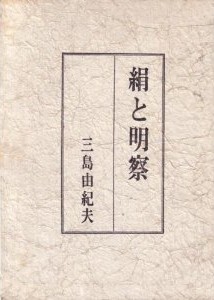Silk and Insight
- View a machine-translated version of the Japanese article.
- Machine translation, like DeepL or Google Translate, is a useful starting point for translations, but translators must revise errors as necessary and confirm that the translation is accurate, rather than simply copy-pasting machine-translated text into the English Wikipedia.
- Do not translate text that appears unreliable or low-quality. If possible, verify the text with references provided in the foreign-language article.
- You must provide copyright attribution in the edit summary accompanying your translation by providing an interlanguage link to the source of your translation. A model attribution edit summary is
Content in this edit is translated from the existing Japanese Wikipedia article at [[:ja:絹と明察]]; see its history for attribution. - You may also add the template
{{Translated|ja|絹と明察}}to the talk page. - For more guidance, see Wikipedia:Translation.
 First edition (publ. Kodansha) | |
| Author | Yukio Mishima |
|---|---|
| Original title | 絹と明察 (Kinu to meisatsu) |
| Translator | Hiroaki Sato |
| Language | Japanese |
| Published | January–October 1964 in Gunzo |
| Publisher | Kodansha |
Publication date | 15 October 1964 |
| Publication place | Japan |
Published in English | 1998 |
| Media type | Print (hardcover) |
| Pages | 299[1] |
| OCLC | 672529106 |
Dewey Decimal | 895.6/35 |
| LC Class | PL833.I7 K55213 1998 |
Silk and Insight (Japanese: 絹と明察, Hepburn: Kinu to meisatsu) is a 1964 novel by the Japanese writer Yukio Mishima. The subject of the novel is taken from an actual strike in Japan in 1954 at Omi Kenshi, a silk thread and fabric manufacturer, which lasted for 106 days.[2] The novel was first serialised in the monthly magazine Gunzo between January–October 1964. It was published in hardcover format by Kodansha on 15 October 1964.[3][4] It was translated into English in 1998 by Hiroaki Sato.
Although a commercial failure, the novel was awarded the Mainichi Prize from Mainichi Shimbun.[5]
Publication
Silk and Insight was first serialised ten times in the monthly magazine Gunzo between January 1964 and October 1964. It was published in hardcover format by Kodansha on 15 October 1964.[3][4] It was published in paperback by Kodansha Bunko on 1 July 1971.[4]
The novel was a commercial failure, with only 18,000 copies published. In comparison, Mishima's novel Kyōko no Ie (1959) sold 150,000 copies in its first month.[5]
Translation
Mishima originally intended for the novel to be translated into English by John Nathan, who Mishima first met in 1963.[6] In 1965, Nathan translated Mishima's The Sailor Who Fell from Grace with the Sea. Impressed by Nathan's translation, Mishima requested Nathan sign on as his translator and help Mishima in his quest in being awarded the Nobel Prize for Literature. Nathan was more interested in translating the work of Kenzaburō Ōe. Nathan initially agreed to translate Silk and Insight, but was unimpressed with it upon his first reading. He ultimately refused to translate the novel, opting instead to translate Kenzaburō Ōe's A Personal Matter. Mishima, who was considered an "arch-rival" of Ōe, abruptly severed ties with Nathan afterwards.[7][8]
Silk and Insight was later translated into English in 1998 by Hiroaki Sato and edited by Frank Gibney as the seventh volume in The Library of Japan series, produced by the Pacific Basin Institute at Pomona College.
Reception
The novel was awarded the Mainichi Prize from Mainichi Shimbun.[5]
Notes
- ^ "絹と明察". CiNii. Retrieved 31 July 2020.
- ^ Sato, Hiroaki. "Introduction" Silk and Insight. M.E. Sharp: 1998. p. xv.
- ^ a b 佐藤秀明; 三島由紀夫; 井上隆史; 山中剛史 (August 2005). 決定版三島由紀夫全集. 新潮社. pp. 433–437. ISBN 978-4-10-642582-0.
- ^ a b c 佐藤秀明; 三島由紀夫; 井上隆史; 山中剛史 (August 2005). 決定版三島由紀夫全集. 新潮社. pp. 540–561. ISBN 978-4-10-642582-0.
- ^ a b c Damian Flanagan (15 August 2014). Yukio Mishima. Reaktion Books. p. 180. ISBN 978-1-78023-419-9.
- ^ Marshall, Colin (26 April 2010). "Unceasing fascination with Japan, immersion in literary culture and the pleasures and sorrows of the "thrown" life: Colin Marshall talks to writer, translator, filmmaker and teacher John Nathan". 3 Quarks Daily. Retrieved 30 July 2020.
- ^ "Literature critic John Nathan dissects Japan's Nobel Prize laureates | The Japan Times". The Japan Times. Retrieved 18 May 2018.
- ^ Morris, Mark (25 October 1998). "Raw Material". The New York Times. Retrieved 14 April 2020.
External links
- NCID BN04558033
- v
- t
- e
- Confessions of a Mask (1949)
- Thirst for Love (1950)
- Forbidden Colors (1951, 1953)
- Death in Midsummer and Other Stories (1952)
- The Sound of Waves (1954)
- The Temple of the Golden Pavilion (1956)
- Kyoko's House (1959)
- After the Banquet (1960)
- The Frolic of the Beasts (1961)
- The Sailor Who Fell from Grace with the Sea (1963)
- The School of Flesh (1964)
- Silk and Insight (1964)
- Acts of Worship (1965)
- Sun and Steel (1968)
- Life for Sale (1968)
- The Sea of Fertility
- Spring Snow (1969)
- Runaway Horses (1969)
- The Temple of Dawn (1970)
- The Decay of the Angel (1971)
- "Death in Midsummer" (1952)
- "Patriotism" (1960)
- "Star" (1960)
- Five Modern Noh Plays (1950–1955)
- The Lady Aoi (1954)
- Iwashi Uri Koi Hikiami (1954)
- Rokumeikan (1956)
- Madame de Sade (1965)
- My Friend Hitler (1968)
- Patriotism (1966)
- The Moon in the Water (1979)
- Mishima: A Vision of the Void (1981)
- Mishima: A Life in Four Chapters (1985)
- 11:25 The Day He Chose His Own Fate (2012)
- Persona: A Biography of Yukio Mishima (2012)
- Tatenokai
- Yukio Mishima Prize
- The Lady Aoi (Bahram Beyzai production)
 | This article about a 1960s novel is a stub. You can help Wikipedia by expanding it. See guidelines for writing about novels. Further suggestions might be found on the article's talk page. |
- v
- t
- e











